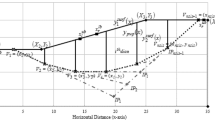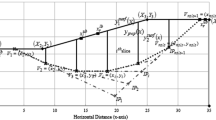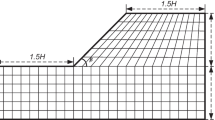Abstract
Rotational failure may exhibit in homogenous rock slopes, and the critical sliding surface of a rock slope based on the rotational failure mechanism is not a single log-spiral under nonlinear failure criterion. This work proposed an advanced nonlinear analysis method for estimating the seismic stability of homogenous slope in rock masses which is governed by the generalized Hoek–Brown failure criterion. According to the virtual power principle, the critical slope height is obtained using particle swarm algorithm. Strength reduction technique is further introduced to explore the reduction strategy of the strength parameters of the Hoek–Brown failure criterion. The outcomes indicate that the factor of safety obtained by simultaneously reducing the unconfined compressive strength σci and material parameter mi is in good agreement with the results of other methods. In addition, two cases are re-analyzed to illustrate the applicability of the proposed method, and the maximum discrepancy with existing results is about 8%. The effects of strength parameters, slope angle, and seismic quasi-static coefficients on the slope stability factor and critical sliding surface are analyzed, which shows that the seismic load and the Hoek–Brown parameters have a significant effect on the slope stability factor. There is no need to assume the expression of the potential sliding surface, which can provide theoretical support and a useful reference for the nonlinear analysis of slope stability.









Similar content being viewed by others
Data Availability
All of the data, models, or code that support the findings of this study are available from the corresponding author upon reasonable request.
Abbreviations
- σ 1 :
-
Major principal stress
- σ 3 :
-
Minor principal stress
- σ ci :
-
Unconfined compressive strength
- m b, s, a :
-
Dimensionless parameters in Hoek–Brown failure criterion
- D :
-
Disturbance factor
- GSI :
-
Geological Strength Index
- m i :
-
Intact rock type-dependent constant
- σ :
-
Normal stress
- τ :
-
Shear stress
- A, B :
-
Dimensionless parameters in Hoek–Brown failure criterion
- σ tm :
-
Unconfined tensile strength of rock mass
- y(x):
-
Potential sliding surface function in the Cartesian coordinate system
- r(θ):
-
Potential sliding surface function in the polar coordinate system
- α, β :
-
Slope angle
- H :
-
Vertical distance from entry point to slope toe
- H 1 :
-
Slope height
- L :
-
Distance from entry point to slope crest
- L 1 :
-
Horizontal distance from entry point to slope crest
- L 2 :
-
Horizontal distance from slope crest to slope toe
- O :
-
Center of rotation
- \(\dot{\Omega }\) :
-
Angular velocity
- φ t :
-
Friction angle
- \(\dot D\) :
-
Internal energy dissipation power per unit area on the sliding surface
- δw :
-
Linear velocity
- \(\Sigma \dot{D}\) :
-
Total internal energy dissipation on the sliding surface
- r 0, θ 0 :
-
Initial radius and initial angle
- r n, θ n :
-
Terminate radius and terminate angle
- k x, k y :
-
Horizontal and vertical seismic acceleration coefficients
- x c, y c :
-
Coordinates of the center of rotation O
- γ :
-
Unit weight of homogenous rock mass
- \({\dot{W}}_{e}\) :
-
Total work rate of external forces
- A 1, B 1, C 1 :
-
Coefficients of univariate quadratic equation
- H f, V f :
-
Horizontal and vertical resultant forces
- M f :
-
Moment of the rotational block to the center of rotation
- I :
-
Total virtual work rate
- δu, δv, δΩ:
-
Horizontal, vertical, and rotational virtual displacements
- F :
-
Core of integral functional I
- X, Y :
-
Cartesian coordinate system with rotation center as origin
- y′:
-
First derivative of sliding surface with respect to x
- σ′:
-
First derivative of normal stress with respect to x
- τ ′ :
-
First derivative of shear stress with respect to x
- λ :
-
Euler-Lagrange coefficient
- G :
-
Function of strength envelope
- f :
-
Hoek-Brown failure criterion with respect to normal stress
- \({F}_{{y}^{^{\prime}}}\) :
-
First derivative of F with respect to y′
- y 1, y 1′:
-
Slope surface function and its first derivative with respect to x
- F s :
-
Safety factor of slope
- Δθ :
-
Increment of θ
- σ 0 :
-
Initial normal stress at entry point
- β′:
-
Calculated slope angle
- H 1′:
-
Calculated slope height
- M :
-
The size of particle swarm group
- P :
-
The number of variables
- x ji, v ji :
-
The position and velocity of particles
- p best, g best :
-
Individual's historical optimal value and the group's optimal value
- c 1, c 2, ω :
-
Parameters of particle swarm algorithm
- k :
-
The current iteration number
- \({\sigma }_{ci}^{cr}\),\({m}_{i}^{cr}\) :
-
Reduced strength parameters
- τ cr, F' s :
-
Reduced shear strength and its corresponding reduction coefficient
- N :
-
Slope stability factor
References
Baker R (2004) Nonlinear mohr envelopes based on triaxial data. J Geotech Geoenviron Eng 130(5):498–506. https://doi.org/10.1061/(asce)1090-0241(2004)130:5(498)
Baker R, Frydman S (1983) Upper bound limit analysis of soil with non-linear failure criterion. Soils Found 23(4):34–42. https://doi.org/10.3208/sandf1972.23.4_34
Benz T, Schwab R, Kauther RA, Vermeera PA (2008) A Hoek-Brown criterion with intrinsic material strength factorization. Int J Rock Mech Min Sci 45(2):210–222. https://doi.org/10.1016/j.ijrmms.2007.05.003
Bishop AW (1955) The use of the slip circle in the stability analysis of slopes. Géotechnique 5(1):7–17. https://doi.org/10.1680/geot.1955.5.1.7
Carranza-Torres C (2021) Computational tools for the analysis of circular failure of rock slopes. IOP Conf Ser: Earth Environ Sci 833:012003. https://doi.org/10.1088/1755-1315/833/1/012003
Chen WF (1975) Limit analysis and soil plasticity. Elsevier, Amsterdam
Chen Y, Lin H (2019) Consistency analysis of Hoek-Brown and equivalent Mohr–coulomb parameters in calculating slope safety factor. Bull Eng Geol Environ 78:4349–4361. https://doi.org/10.1007/s10064-018-1418-z
Collins IF, Gunn CIM, Pender MJ, Yan W (1988) Slope stability analyses for materials with a non-linear failure envelope. Int J Numer Anal Methods Geomech 12(5):533–550. https://doi.org/10.1002/nag.1610120507
Deng DP, Li L, Wang JF, Zhao LH (2016) Limit equilibrium method for rock slope stability analysis by using the Generalized Hoek-Brown criterion. Int J Rock Mech Min Sci 89:176–184. https://doi.org/10.1016/j.ijrmms.2016.09.007
Drescher A, Christopoulos C (1988) Limit analysis slope stability with nonlinear yield condition. Int J Numer Anal Methods Geomech 12(3):341–345. https://doi.org/10.1002/nag.1610120307
Fu WX, Liao Y (2010) Non-linear shear strength reduction technique in slope stability calculation. Comput Geotech 37(3):288–298. https://doi.org/10.1016/j.compgeo.2009.11.002
Hammah RE, Yacoub TE, Corkum BC and Curran JH (2005) The shear strength reduction method for the generalized Hoek-Brown criterion. Am Rock Mech Assoc - 40th US Rock Mech Symp ALASKA ROCKS 2005 Rock Mech Energy, Miner Infrastruct Dev North Reg
Hoek E, Brown ET (1980) Underground Excavations in Rock. Institution of Mining and Metallurgy, London
Hoek E, Brown ET (1997) Practical estimate the rock mass strength. Int J Rock Mech Min Sci 34(8):1165–1186. https://doi.org/10.1016/s1365-1609(97)80069-x
Hoek E, Brown ET (2018) The Hoek-Brown failure criterion and GSI–2018 edition. J Rock Mech Geotech Eng 11(3):445–463. https://doi.org/10.1016/j.jrmge.2018.08.001
Hoek E, Wood D, Shah S (1992) A modified Hoek-Brown criterion for jointed rock masses. In: Hudson JA (ed) Rock characterization: ISRM Symposium, Eurock ‘92, Chester, UK. Thomas Telford, London, pp 209–213
Hoek E, Marinos P, Benissi M (1998) Applicability of the Geological Strength Index (GSI) classification for very weak and sheared rock masses, the case of the Athens Schist Formation. Bull Eng Geol Environ 57(2):151–160. https://doi.org/10.1007/s100640050031
Hoek E, Marinos P, Marinos V (2005) Characterization and engineering properties of tectonically undisturbed but lithologically varied sedimentary rock masses. Int J Rock Mech Min Sci 42(2):277–285. https://doi.org/10.1016/j.ijrmms.2004.09.015
Hoek E, Kaiser PK, Bawden WF (1995) Support of underground excavations in hard rock. A.A. Balkema, Rotterdam, the Netherlands
Hoek E, Carranza-Torres C, Corkum B (2002) Hoek-Brown criterion-2002 edition. Narms-Tac, pp 267–273
Hu SH, Zhao LH, Tan YG, Yang F, Wang ZB, Zhao ZG (2021) Variation analysis of uplift bearing characteristics of strip anchor plate in nonhomogeneous materials. Int J Geomech 21(4):04021037. https://doi.org/10.1061/(ASCE)GM.1943-5622.0001974
Hu SH, Zhao LH, Tan YG, Luo YB, Zeng ZL (2022) Three-dimensional upper-bound limit analysis of ultimate pullout capacity of anchor plates using variation method. Int J Numer Anal Methods Geomech 1–24. https://doi.org/10.1002/nag.3349
Huang S, Hu SH, Zhao LH, Zeng ZL (2021) Stability analysis of deep rectangular tunnels using adaptive finite element limit analysis with Hoek-Brown failure criterion. Arab J Sci Eng 46:10931–10941. https://doi.org/10.1007/s13369-021-05632-5
Jiang X, Cui P, Liu C (2016) A chart-based seismic stability analysis method for rock slopes using Hoek-Brown failure criterion. Eng Geol 209:196–208. https://doi.org/10.1016/j.enggeo.2016.05.015
Kennedy J, Eberhart R (1995) Particle swarm optimization. Proceedings of ICNN’95-international conference on neural networks, Perth, WA, Australia, (4):1942–1948. https://doi.org/10.1109/ICNN.1995.488968
Kumar P (1998) Shear failure envelope of Hoek-Brown criterion for rock mass. Tunn Undergr Space Technol 13(4):453–458. https://doi.org/10.1016/s0886-7798(98)00088-1
Kumar V, Himanshu N, Burman A (2019) Rock slope analysis with nonlinear Hoek-Brown criterion incorporating equivalent Mohr-Coulomb parameters. Geotech Geol Eng 37(6):4741–4757. https://doi.org/10.1007/s10706-019-00935-9
Li AJ, Merifield RS, Lyamin AV (2008a) Stability charts for rock slopes based on the Hoek-Brown failure criterion. Int J Rock Mech Min Sci 45(5):689–700. https://doi.org/10.1016/j.ijrmms.2007.08.010
Li YY, Yin KL, Dai YX (2008b) Stability analysis of rock slope by strength reduction method based on generalized Hoek-Brown failure criterion. Rock Soil Mech 28(S1):347–352. https://doi.org/10.16285/j.rsm.2008.s1.112
Li AJ, Lyamin AV, Merifield RS (2009) Seismic rock slope stability charts based on limit analysis methods. Comput Geotech 36(1–2):135–148. https://doi.org/10.1016/j.compgeo.2008.01.004
Li AJ, Merifield RS, Lyamin AV (2011) Effect of rock mass disturbance on the stability of rock slopes using the Hoek-Brown failure criterion. Comput Geotech 38(4):546–558. https://doi.org/10.1016/j.compgeo.2011.03.003
Li AJ, Cassidy MJ, Wang Y, Merifield RS, Lyamin AV (2012) Parametric Monte Carlo studies of rock slopes based on the Hoek-Brown failure criterion. Comput Geotech 45:11–18. https://doi.org/10.1016/j.compgeo.2012.05.010
Marinos P, Hoek E (2000) GSI: A geologically friendly tool for rock mass strength estimation. In: Proc. GeoEng2000 at the Int. Conf. on Geotechnical and Geological Engineering, Melbourne, Technomic publishers, Lancaster, Pennsylvania, pp 1422–1446
Marinos P, Hoek E (2001) Estimating the geotechnical properties of heterogeneous rock masses such as flysch. Bull Eng Geol Environ 60(2):85–92. https://doi.org/10.1007/s100640000090
Michalowski RL, Park D (2020) Stability assessment of slopes in rock governed by the Hoek-Brown strength criterion. Int J Rock Mech Min Sci 127:104217. https://doi.org/10.1016/j.ijrmms.2020.104217
Renani HR, Martin CD (2020) Slope stability analysis using equivalent Mohr-Coulomb and Hoek-Brown criteria. Rock Mech Rock Eng 53(1):13–21. https://doi.org/10.1007/s00603-019-01889-3
Shen J, Karakus M, Xu C (2012a) Direct expressions for linearization of shear strength envelopes given by the Generalized Hoek-Brown criterion using genetic programming. Comput Geotech 44:139–146. https://doi.org/10.1016/j.compgeo.2012.04.008
Shen J, Priest SD, Karakus M (2012b) Determination of Mohr-Coulomb shear strength parameters from generalized Hoek-Brown criterion for slope stability analysis. Rock Mech Rock Eng 45(1):123–129. https://doi.org/10.1007/s00603-011-0184-z
Shen J, Karakus M, Xu C (2013) Chart-based slope stability assessment using the Generalized Hoek-Brown criterion. Int J Rock Mech Min Sci 64:210–219. https://doi.org/10.1016/j.ijrmms.2013.09.002
Song K, Yan EC, Mao W, Zhang TT (2012) Determination of shear strength reduction factor for generalized Hoek-Brown criterion. Chin J Rock Mech Eng 31(01):106–112 ((In Chinese))
Sun CW, Chai JR, Xu ZG, Qin Y, Chen XZ (2016) Stability charts for rock mass slopes based on the Hoek-Brown strength reduction technique. Eng Geol 214:94–106. https://doi.org/10.1016/j.enggeo.2016.09.017
Tang GP, Zhao LH, Li L, Yang F (2015) Stability charts of slopes under typical conditions developed by upper bound limit analysis. Comput Geotech 65:233–240. https://doi.org/10.1016/j.compgeo.2014.12.008
Tang GP, Zhao LH, Li L, Chen JY (2017) Combined influence of nonlinearity and dilation on slope stability evaluated by upper-bound limit analysis. J Cent South Univ 24(7):1602–1611. https://doi.org/10.1007/s11771-017-3565-y
Wu SC, Jin AB, Gao YT (2006) Numerical simulation analysis on strength reduction for slope of jointed rock masses based on gereralized Hoek-Brown failure criterion. Chin J Geotech Eng 11(28):1975–1980 ((In Chinese))
Yang XL, Yin JH (2010) Slope equivalent Mohr-Coulomb strength parameters for rock masses satisfying the Hoek-Brown criterion. Rock Mech Rock Eng 43(4):505–511. https://doi.org/10.1007/s00603-009-0044-2
Yang XL, Li L, Yin JH (2004a) Stability analysis of rock slopes with a modified Hoek-Brown failure criterion. Int J Numer Anal Methods Geomech 28(2):181–190. https://doi.org/10.1002/nag.330
Yang XL, Li L, Yin JH (2004b) Seismic and static stability analysis for rock slopes by a kinematical approach. Géotechnique 54(8):543–549. https://doi.org/10.1680/geot.2004.54.8.543
Yuan W, Li JX, Li ZH, Wang W, Sun XY (2020) A strength reduction method based on the Generalized Hoek-Brown (GHB) criterion for rock slope stability analysis. Comput Geotech 117:1–16. https://doi.org/10.1016/j.compgeo.2019.103240
Zhang XJ, Chen WF (1987) Stability analysis of slopes with general nonlinear failure criterion. Int J Numer Anal Methods Geomech 11(1):33–50. https://doi.org/10.1002/nag.1610110104
Zhao LH, Cheng X, Li L, Chen JQ, Zhang YB (2017a) Seismic displacement along a log-spiral failure surface with crack using rock Hoek-Brown failure criterion. Soil Dyn Earthq Eng 99:74–85. https://doi.org/10.1016/j.soildyn.2017.04.019
Zhao LH, Cheng X, Dan HC, Tang ZP, Zhang YB (2017b) Effect of the vertical earthquake component on permanent seismic displacement of soil slopes based on the nonlinear Mohr-Coulomb failure criterion. Soils Found 57(2):237–251. https://doi.org/10.1016/j.sandf.2016.12.002
Zhao LH, Yang XP, Huang F, Tang YG, Hu SH (2018) Variational analysis of the ultimate pullout capacity of shallow circular anchor plates in rock foundations based on the Hoek-Brown failure criterion. Int J Rock Mech Min Sci 106:190–197. https://doi.org/10.1016/j.ijrmms.2018.04.027
Zhao LH, Hu SH, Yang XP, Huang F, Zuo S (2019) Limit variation analysis of shallow rectangular tunnels collapsing with double-layer rock mass based on a three-dimensional failure mechanism. J Cent South Univ 26(7):1794–1806. https://doi.org/10.1007/s11771-019-4134-3
Zhao LH, Jiao KF, Li DJ, Li DJ, Zuo S (2020a) System reliability analysis of seismic pseudo-static stability of rock wedge based on nonlinear Barton−Bandis criterion. J Cent South Univ 27(11):3450–3463. https://doi.org/10.1007/s11771-020-4558-9
Zhao LH, Yu CH, Cheng X, Zuo S, Jiao KF (2020) A method for seismic stability analysis of jointed rock slopes using Barton-Bandis failure criterion. Int J Rock Mech Min Sci 136:104487. https://doi.org/10.1016/j.ijrmms.2020.104487
Zuo S, Zhao LH, Deng DP, Wang ZB, Zhao ZG (2020) Reliability back analysis of landslide shear strength parameters based on a general nonlinear failure criterion. Int J Rock Mech Min Sci 216:104189. https://doi.org/10.1016/j.ijrmms.2019.104189
Acknowledgements
This study was financially supported by National Natural Science Foundation of China (Nos. 51878668, 51978666), Distinguished Young Scholar Foundation of Hunan Province (No. 2021JJ10063), Scientific and technological progress and innovation project of Department of Transportation of Hunan Provincial (No. 202115), and Postgraduate Innovative Project of Central South University (No. 150110068). The Natural Science Foundation of Hunan Province (2023JJ40078) and the Scientific Research Project of Hunan Provincial Education Department (No. 22C0573). Additionally, the fourth author, Shi Zuo, led both of these projects. All financial supports are greatly appreciated.
Author information
Authors and Affiliations
Contributions
All authors contributed to the study conception and design. Methodology, code, data calculation and analysis, and comparison were performed by Shihong Hu, Liang Li and Lianheng Zhao. Figures and Tables were performed by Shihong Hu, Shi Zuo and Dongliang Huang. The first draft of the manuscript was written by Shihong Hu and Lianheng Zhao, and all authors commented on previous versions of the manuscript. All authors read and approved the final manuscript.
Corresponding author
Ethics declarations
Competing of interests
The authors declare that they have no known competing financial interests or personal relationships that could have appeared to influence the work reported in this paper.
The authors declare the following financial interests/personal relationships which may be considered as potential competing interests:
Rights and permissions
Springer Nature or its licensor (e.g. a society or other partner) holds exclusive rights to this article under a publishing agreement with the author(s) or other rightsholder(s); author self-archiving of the accepted manuscript version of this article is solely governed by the terms of such publishing agreement and applicable law.
About this article
Cite this article
Hu, S., Li, L., Zhao, L. et al. Strength reduction strategy for rock slope stability using the variation principle based on the Hoek–Brown failure criterion. Bull Eng Geol Environ 82, 297 (2023). https://doi.org/10.1007/s10064-023-03303-3
Received:
Accepted:
Published:
DOI: https://doi.org/10.1007/s10064-023-03303-3




